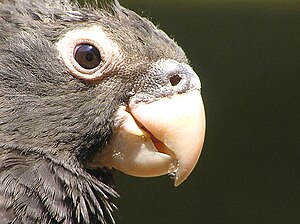Great Vasa Parrot
| Great Vasa Parrot | ||||||||||||
|---|---|---|---|---|---|---|---|---|---|---|---|---|

Great Vasa Parrot ( Coracopsis vasa ) |
||||||||||||
| Systematics | ||||||||||||
|
||||||||||||
| Scientific name | ||||||||||||
| Coracopsis vasa | ||||||||||||
| ( Shaw , 1812) |
The Great Vasa Parrot ( Coracopsis vasa ) is a species of parrot that lives in Madagascar and the Comoros . Together with the small Black Parrot ( Coracopsis nigra ), it forms the genus of Vasa Parrots ( Coracopsis ).
Appearance
Large vasa parrots reach a length of around 50 centimeters and a weight of 480 grams. The animals of the nominate form ( C. v. Vasa ) are colored black-brown, whereby the wings can be gray. They have clearly visible, featherless dark circles. The massive beak, which is significantly larger than that of the Little Vasa Parrot, is horn-colored. After moulting, the beak is gray-black in color. The sexes show no sexual dimorphism , only the females lose feathers on their heads during breeding, which makes the yellowish-orange skin shimmer through. The subspecies C. v. drouhardi and C. v. comorensis resemble the nominate form, but are a little lighter.
Distribution area
The nominate form C. v. vasa lives in eastern Madagascar, the subspecies C. v. drouhardi in the west of this island and C. v. comorensis in the Comoros. They inhabit different habitats and can be found in moist forests as well as in dry forests and savannas.
Way of life
The Greater Vasa Parrot is usually found in small groups of 10 to 15 birds. Large flocks of up to 200 birds can come together to search for food and to rest at night. As they approach feeding and resting places, they fly high above the treetops. They feed mainly on fruits, berries, nuts and seeds.
The mating season is between October and December. The female lays three to four eggs in tree hollows; the young hatch after around 17 days of breeding season.
population
Large vasa parrots are common. They are sometimes hunted for their meat or because they prey on crops. According to the IUCN, the species is not endangered ( least concern ).
Others
For 30 years, Alexander von Humboldt kept a large Vasa parrot named Jakob , which the Grand Duke of Saxe-Weimar-Eisenach had bequeathed to him. After the parrot died, Humboldt gave it to the Berlin Natural History Museum . There the bird was prepared. The preparation, which was damaged by a grenade in World War II, has now been reassembled and functions as a symbol of the museum.
literature
- Franz Robiller: New Zealand, Australia, Oceania, Southeast Asia and Africa. Ulmer, Stuttgart 1997, ISBN 3-8001-7229-1 ( Parrots. Volume 2).
- Susanne and Werner Lantermann (1986): The parrots of Central and South America: Species, keeping a. Zucht , Verlag M. & M. Schaper, ISBN 3-7944-0149-2
Individual evidence
- ↑ Historical parrot: Humboldt had a bird. Retrieved September 30, 2019 .
Web links
- Coracopsis vasa in the endangered Red List species the IUCN 2009. Posted by: BirdLife International, 2009. Retrieved on November 5 of 2009.
- Information at parrots.org (English)
